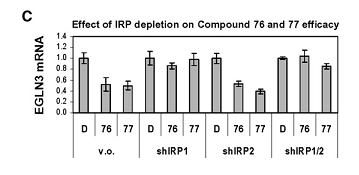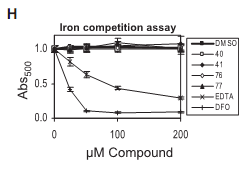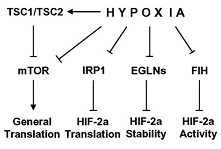Hypoxia, Article Critique Example
Background Summary
In this research, the researchers are seeking to find out the mechanism of how cells can adopt to hypoxia. It has been found out through various research processes on hypoxia that cells do adapt to hypoxia through the decrease of translation of proteins. However, during this process, the proteins, which are vital in responding to hypoxia, do evade the process. This is what remains unclear to various scientists, and it is the problem, which drove these researchers to carry out this research study.
Following the dangers that accompany the inadequacy of oxygen in the body tissues, there was a dire need for research to be done to find out the principles behind the unclear phenomenon. The researchers seemingly wanted to explain why the proteins, which are expected to provide an immediate response to hypoxia, evade the translational repression. This had not yet been established, and this is what seemingly motivated the researchers. Before a research is carried out, there has to be a source of inspiration towards carrying out research in a given area. Research cannot just be carried out for knowledge. Well, it is true to argue that research is for knowledge. This is because the findings of a given research will form a knowledge basis for a student in a given area. However, this may not be the core reason. Most researchers want to leave behind a legacy after doing a fruitful research. They would even want to patent findings from a given research to avoid any form of duplication, so that all credit can be given to them. Therefore, in this case, this might be the main motivation for the researchers since no one could explain the unique behavior of proteins towards hypoxia.
Before the publication of this paper, there was already a lot that had been written about hypoxia. It had already been established that hypoxia triggers various pathways that are often complex. This occurs both at the cellular level and organism level. The ultimate goal of the trigger is usually the restoration of the homoeostasis of oxygen in the tissues. Research has also revealed that there many responses, physiologically, in response to hypoxia. However, little has so far been done concerning the molecular processes in response to hypoxia. The research in this publication about hypoxia is among the various research studies that are in progress. Therefore, the findings made by these researchers are an extraordinary achievement. This is because it forms part of the first studies seeking to explain the molecular processes in the body in response to low oxygen levels.
The researchers as shown in this article sought to “carry out a succinct genetic analysis describing the process and mechanism that facilitates the translation and retention of message of HIF-2a during conditions of extreme hypoxia”. This was possible was considering the repression that occurs in IRP-1 through the selective screening of HIF-2a.
It is evident from the article that various experiments were carried out in order facilitate the realization of the objective of the study. The first experiment on culture and transfection is characterized by cell-line characterization by growing plasmids in DMEV. With the help of standard buffers, it was possible to order the Sigmas obtained. Eventually, there was knocking of IRP1 and IRP2, which led to the expression of IRE-luciferase performed in PDARS.

The second experiment involved the screening of HIF-2a inhibitors through the plating 7H4 with the sequential addition of compounds to the optimal 10 microM. It was important to establish the concentration of Luciferase activity whilst in duplicates as controls. It was necessary to carry out the third experiment on real-time quantification of RNA using PCR analysis. In this process, reverse transcription of hexamer primers was carried out whilst minimizing any instance of contamination. From the primers used, nascent information from HIF-2a was determined.

The fourth experiment involved the profiling of genes in the RNA that was used and the eventual mapping using real time PCR. With the help of qRT-PCR thresholds were set at minimum of 20 and a maximum of sixteen thousand gene sets which facilitated the process of clustering using the appropriate software. Eventually, gene expression signatures were analyzed paving way for the HUVEC assay. In this assaying experiment, cells were plated in HUVEC and replaced in tissue culture after 24 hours. Quantitative analysis was possible through a calorimetric method.
The subsequent experiment was that of Western blots where antibodies of monoclonal anti-HIF-2a, anti-HIF-1a, and Glut-1 among others were analyzed. The induction of hypoxia during this experiment was determined through the replacement of fresh plates of cells incubated at 370C. With the duplicate nature of sets prepared, it was possible to place the sets being evaluated in different environmental conditions like presence of oxygen and CO2 and another one without oxygen all at 370C.
ELISA was performed on VEGF conditioned in quantikine kits. Other important experiments during this study were the EMSA, S-methionine Pulse label and cycloheximine experiments. For the determination the relationship of iron and hypoxia, assaying of iron in vitro through competition was carried out. With the displacement of realized when using EDHB complex, it was possible to determine its absorbance in the aliquots used.

The discovery of HIF (Hypoxia-Inducible Factor), which is a transcription factor that responds to hypoxia, gave enormous strides and strength to the ongoing studies. The discovery of HIF regulators resulted to findings about the complex control mechanism over the family of the transcription factor. Research has also revealed that the tumor that gives promotion to the Hypoxia-Inducible Factor is a central cellular response regulator in relation to hypoxia. HIF has been found to possess constitutively expressed (HIF-b) and the hypoxia-regulated (HIF-a). HIF-a has two isoforms, which cannot undergo any activity without the presence of oxygen. Oxygen regulates their activities. These isoforms are HIF-1a and HIF-2a.
HIF-A is targeted by the tumor suppressor protein pVHL, in cells that have enough oxygen, for ubiquitination and proteasomal degradation. This interaction needs HIF-a to undergo hydroxylation in the presence of proline residues. The process of hydroxylation is done by prolylhydroxylases, which dependent largely on iron, called EGLN1, EGLN2, and EGLN3. These prolylhydroxylases are molecular sensors of oxygen that are found within the cells. The way of regulation of these enzymes within the cell structure and the other potential targets it has is still under investigation. It has not been clearly established how these enzymes are kept within the required amounts. Research has farther revealed the inhibitory role played by hypoxia onto the activity of EGLN. Hypoxia farther interferes with the interaction between HIF and pVHL. The subunits of HIF-a that have stabilized usually get into the nucleus, heterodimerize with HIF-1b before binding to the sequences of the DNA, which are called hypoxia response elements (HREs). While here, they Trans-activate genes, which encode for proangiogenic factors, and secreted growth.
It has also already been established that Factor-Inhibiting HIF (FIH), usually attenuates the transcriptional activity of HIF. Facto-Inhibiting HIF is an iron-dependent enzyme, which hydroxylates an asparagines residue that has been conserved in the HIF domain of trans-activation. However, the healthy cells have counteracted to the hypoxia effects by adapting to the low oxygen concentration levels. For instance, one of the main adaptive responses that healthy cells have adopted against hypoxia is the conservation of energy through the diminishing of the translation of the global proteins. This process is enhanced by Redd1, which is a HIF target gene, through inhibition of mTOR using the tuberous sclerosis complex. This translational repression, nevertheless, does not affect the certain messages which enable adjust to the hypoxic environment. This is the information currently discovered. However, the mechanisms that enhance the selective translation of some messages in hypoxia conditions are still being investigated.
Inevitably, the assembly of iron-sulfur clusters in mammals is a process marked with much complexity because it utilizes several enzymes and other proteins that are much needed. These iron-sulfur clusters result from various proteins from yeast and bacteria. There are various proteins involved in the process, which work together with enzymes. These are the likes of reducing proteins like ferredoxin and glutaredoxin, iron donor proteins such as frataxin, chaperone and co-chaperone proteins, significant in the process of protein folding, during the transfer of nascent clusters from the scaffold proteins to the recipient proteins.
It is quite evident that adequate sources of sulfur an iron are required for the process of iron-sulfur assembly. Iron-sulfur cluster assembly proteins are supposed to be deficient at this time since they seriously inhibit the iron-cluster assembly process. Whenever the iron-sulfur cluster assembly protein is expressed, there is a remarkable reduction in the iron-deficient cells. As a result, there emerges a possibility of the iron-sulfur switch of IRP1 being influenced both by the availability of iron and the appearance of these cluster assembly proteins.
Discussion of the Results
The researchers, who wrote this paper concerning hypoxia, did some intensive research studies. They made use of various methods, to proof and verify their findings. Their research was based on experiments; therefore, it was an experimental research type. They tirelessly worked round the clock studying the cellular structure and their response in the absence of adequate oxygen supply.
The researchers used a cell-based analysis for the activity of the HIF. They found out that there were small molecule inhibitors of HIF. These inhibitors reduced both the hypoxia-induced and constitutive HIF-2a expressions of proteins. The HIF inhibitors revealed the IRP1 to be a hypoxia-sensitive regulator of the translation of HIF, analogous to EGLN- and FIH-mediated hypoxic instruction of HIF constancy and transcriptional movements. The researchers, consequently, concluded that hypoxia condition does regulate the translation of HIF, the transcriptional activity and stability. This is as illustrated in the figure 8 A in the research paper, as shown below:

The figure shows the effects that the hypoxia condition has on the HIF-2a and the global translation that occurs. Hypoxia influences the various enzymatic activities within the cellular structure, which yields translation of cellular proteins and stability.
When they are used to investigate genes, HIF inhibitors underscored IRP1 because they are perceptive controllers of hypoxia especially in the translation of HIF. Consequently, the chemical is important in manipulating hypoxia that emanates from FIH and relies in the constancy of HIF. As it can be seen from the study, any hypoxic condition affects the production of HIF its constancy, translation, and successful transcription. It has been shown that this condition succeeds through the inhibition of any activity of HIF and the mechanisms that follow. This is a clear indication that HIF translation is amenable to drug development. Additionally, several of these compounds will hinder HIF translation under the direction of IRP1.
Essentially, the occurrence of hypoxic conditions limits the translation that is often enhanced by mTOR and phosphorylation. From the study, this is important in developing serious understanding on the way tumor cells arise and the eventual elevated levels of mTOR activity. Additionally, it is shown from the study that the change in the genetic make-p of an organism play a critical role in the causation of chronic hypoxia which is often lethal to a victim. The successful remedy of such a situation requires cells to translate the appropriate stress response genes efficiently. This is only probable in instances where there is inherent attenuation of mRNA translation. Essentially, the selective translation of factors like FGF2, VEGFB, ATF4, Glut-1, Angiopoietin-like four, Hypoxia-inducible Gene 2, increases the translational speci?city, which is often enhanced by 30UTR.
From the data obtained in this study, one can easily deduce that HIF-2a, conform to the above paradigm although it plays a critical role in rectifying all instances of hypoxia. This leads to the eventual reduction of IRP1 and the increase in IRP2 levels. Under normoxic circumstances, the binding of IRP1 and HIF-2a affects the translation of IRE from the basal perspective. Hypoxia depresses HIF-2a translation by mediating posttranslational changes in IRP1.
It is necessary to put into perspective the state of iron-sulfur switch of IRP1. This can be determined by both the synthesis of iron-sulfur cluster and the rate at which the clusters turn over. Oxidation and destabilization of the iron-sulfur cluster of IRP1 is done by oxygen, peroxynitrite and nitric oxide. This may also be done through indirect disassembly by hydrogen peroxide.
Conclusion and Recommendations
From various studies carried out on animals, it is quite evident that the IRP-IRE regulatory system plays a significant role as far as psychology is concerned. The venturing into the in-depth study on the same promises to bring substantial insight regarding the iron-sulfur cluster assemblage in mammals and the various elements that operate the switch of IRP1. There is still much that has to be established, especially regarding the processes involved in the targeting of IRP2 for iron-dependent degradation as well as the processes through which IRP2 transcription depends on selected growth signals. The most appropriate model used in the dissection of neuronal death can be done emanates from the neurodegeneration IRP2-/- mice. In case the functional iron deficiency results in the dysfunction of mitochondria, and in the end there is free basal stress coupled with the failure to produce energy in the axons such information unravels a neurodegenerative means of comprehending the pathophysiology of several diseases. The common thing about these diseases is that there is suspicion of iron misregulation being a leading player.
Considering the conventional approach, gene analysis carried out in the event of hypoxia usually centers majorly on HIF-mediated transcriptional responses. One overriding factor to note in this regard is the fact that the hypoxic stress in the cells usually results into quite a number of paths. For a well-synchronized and coordinated response in such a case, there is always the need of integrating all these pathways. Therefore, the analysis of the hypoxia response should always put into consideration chromatin reorganization, mRNA as well as the translational processes as new faces. It is also worthwhile to include cross talk with various transcription factors for the sake of modulating HIF activity. In future, studies in this regard will provide sufficient information and knowledge about the determination of gene expression profile of a cell under hypoxia in order to be able to use the knowledge in pathological situations in an appropriate manner.
The IRE-IRP regulatory system is of immense significance as far as the physiological state of a developing embryo is concerned. This is because in the absence of IRP1 and IRP2, the embryo will always die at the blastocyst stage before the actual implantation process. As such, this system is paramount in the regulation of iron metabolism. In cases where TfR1 is expressed, it is common to find a case of functional iron deficiency, which has a significant impact on axons. These are considerably dependent on iron-replete mitochondria for the purpose of generating ATP useful in the transport and functioning of axons. The study is a basis of other studies in related field especially concerning the process of hypoxia and the way one can evade it scientifically.

Time is precious
don’t waste it!

Plagiarism-free
guarantee

Privacy
guarantee

Secure
checkout

Money back
guarantee






